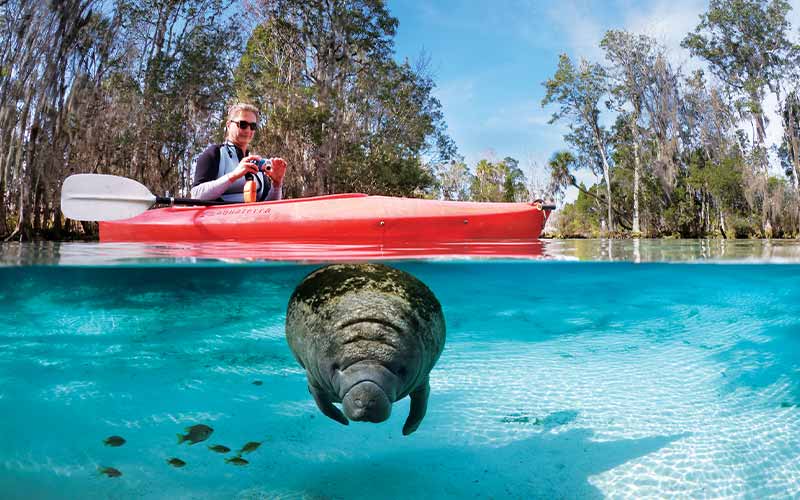“Gee whiskers!” Little Orphan Annie used to exclaim. Her once-common catchphrase could apply anew to some extraordinary things we are learning about the whiskered Florida manatee. Manatee mothers and their calves form a strong bond that lasts for two years or more. During this time the little ones learn what they need to know to survive, including what to eat, where to go and how to stay warm, as well as manatee social skills.
What happens when a little manatee calf is orphaned? It turns out that a mother manatee, even one with her own calf, will sometimes adopt an orphan in need. This adoption behavior has been witnessed at Three Sisters Springs, part of the Crystal River National Wildlife Refuge in Florida.
“From genetic studies using an exclusion process based on inherited markers, we have observed adoption of unrelated calf manatees by lactating mothers,” said manatee expert Bob Bonde, wildlife biologist with the U.S. Geological Survey’s Sirenia Project. “Although not common, this has been observed in a few cases during long-term studies conducted in Crystal River, Fla.”

Last winter back in the springs, we noticed a very skinny female calf without a mother, vocalizing repeatedly with loud squeaks. She must have been orphaned quite young; she would approach any manatee, regardless of age or gender, squeaking loudly and attempting to nurse under any available ?ipper. We notified the proper authorities.
Later we observed this little orphan nursing from one particular adult female over subsequent weeks. From our photographs, the team at the Sirenia Project identified the potential adoptive mother. Cathy Beck, wildlife biologist, said this adoptive mother is CR554, a female ?rst documented in March 1999. “Since that ?rst sighting, she has been seen with four calves in addition to this young adoptee,” Beck said. “CR554 has several subtle but unique features that we use to identify her, including two small tail notches and a white scar on her tail — visible despite the algae coating her skin.”
It was touch and go for a while as the skinny orphan hadn’t ever learned to stay with one mother, but the mother manatee was seen nursing the orphan more and more often. Sometimes she would leave her rotund older calf up in the springs to play while she went to nurse the hungry orphan.
As the weather warmed, the whiskered threesome was seen less frequently. This was taken as an encouraging sign that the mother, her older calf and the little orphan had all happily bonded and had ventured out to pursue their lives elsewhere. When I think about the privilege to peek into the manatee’s world and witness this tender and caring bonding of mother, calf and orphan, all I can say is, “Gee whiskers!”
How to Help
If you see a manatee in distress, call the 24-hour manatee hotline at 1-888-404-FWCC.
Ivan Vicente, visitor services specialist at the Crystal River National Wildlife Refuge, said the refuge enlists about 60 Manatee Watch volunteers each manatee season in Crystal River, but more than half the reports of manatees in distress come from visitors who snorkel near the animals. “They pass on their observations to the Manatee Watch volunteers or tour operators, who further observe, photograph or film the manatees in question. Most snorkeling visitors carry underwater cameras, and their photos and video footage are critical in helping to determine whether a manatee needs rescue,” Vicente said.
© Alert Diver — Q4 Fall 2012